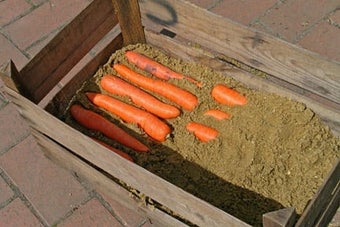
Quick facts
Common name - Splitting of root vegetables
Plants affected - Beetroot, carrots, parsnips and other root vegetables
Main causes - Irregular watering and rain
Timing - Summer and autumn
What is root splitting?
Symptoms
On digging, the vegetable root will show the following;
- The flesh of the root is cracked or deeply split
- Splits run longitudinally, usually starting at the top of the root, and can be deep, revealing the core of the root
- Initially the rest of the root appears healthy but splitting can lead to secondary infections, such as bacterial soft rots , taking hold and causing roots to become soft and inedible
Control
The occurrence of root splitting can be reduced in a number of ways.
Non-chemical control
- Improve garden soils over time, digging in plenty of well-rotted organic matter to increase the soil’s water-holding capacity. Carrots are not usually grown on freshly-manured ground; instead, manure the ground the preceding autumn or before the previous crop
- Regular watering to ensure a steady growth rate is essential, especially in sandy or chalky soils that are not very moisture-retentive. In dry weather, water crops thoroughly every two weeks initially, rising to every week as the roots near their harvest stage
- Where this problem regularly occurs, look for cultivars sold as being able to resist splitting, such as carrots ‘Bangor’ and ‘Autumn King 2’
- Remove affected roots as soon as the problem is suspected in order to be able to use flesh before rots set in; clean mud from cracks thoroughly before use
- Harvest beetroot, carrots and other less-hardy roots before the first frosts in autumn
Chemical control
There are no chemical treatments available for this problem.
Cause
An erratic supply of water, such as high rainfall after long periods of drought, is the main cause of splitting. In these conditions, roots suddenly take up a great deal of water and undergo a surge in growth that their structure cannot cope with. A similar phenomenon occurs in many fruits.
Carrots are most prone to splitting, with larger-rooted cultivars worse affected than small ones, as they can take up more water. The damage mainly occurs in summer but is often not discovered until harvest time. Occasionally splitting and shattering can occur at harvest time if roots have recently absorbed a sudden excess of water after a period of drought.
Excess nitrogen fertiliser and fluctuating temperatures may also have an impact on splitting and some roots are split by frosts.
Viruses transmitted by the willow-carrot aphid can cause roots to split open completely (known as ‘kippering’). Protection using fleece or insect-proof mesh for carrot fly will also keep aphids off crops.




